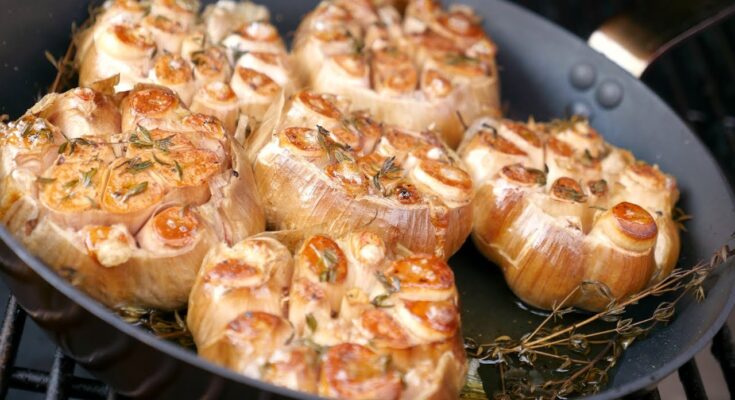Roasted Garlic Recipe: Roasted garlic is a culinary gem that transforms any dish with its sweet, nutty, and mellow flavor. Unlike raw garlic, which is sharp and pungent, roasted garlic has a creamy texture and caramelized sweetness that enhances recipes from soups to sauces. Its versatility makes it a must-have in every kitchen.
Not only does roasted garlic elevate your cooking, but it also comes with numerous health benefits. Packed with antioxidants, roasted garlic aids digestion, boosts immunity, and has heart-friendly properties.
Ready to roast some garlic? Let’s dive into this simple yet delicious recipe.
Ingredients and Tools
To get started, gather the following:
Ingredients:
- 1-2 whole garlic bulbs
- 2-3 tablespoons of olive oil
- A pinch of sea salt
- Optional: Fresh thyme, rosemary, or cracked black pepper
Tools:
- Aluminum foil or a small oven-safe dish with a lid
- Sharp knife
- Baking tray
- Oven mitts
Preparing the Garlic
- Choosing the Garlic: Pick firm, plump garlic bulbs with tight, unbroken skin. Fresh garlic ensures a better taste and texture after roasting.
- Cleaning the Bulbs: Gently brush off dirt or debris from the garlic bulb. Avoid using water to wash it as it can make the skin soggy.
- Trimming the Head: Using a sharp knife, cut about ¼ inch off the top of the garlic bulb. This exposes the cloves, allowing the oil to seep in and enhance the flavor during roasting.
Wrapping and Seasoning
- Preparing the Foil: Tear a square piece of aluminum foil large enough to wrap the garlic bulb completely.
- Seasoning the Garlic: Place the trimmed garlic bulb on the foil. Drizzle it generously with olive oil, making sure the oil seeps into the exposed cloves. Sprinkle a pinch of sea salt and add optional herbs like thyme or rosemary for added aroma.
- Wrapping It Up: Wrap the foil snugly around the garlic bulb, ensuring no gaps. This traps heat and helps roast the garlic evenly.
Roasting Process
- Preheating the Oven: Preheat your oven to 400°F (200°C). A consistent temperature is key for perfectly roasted garlic.
- Baking: Place the foil-wrapped garlic bulb on a baking tray. Roast it in the preheated oven for 40-60 minutes. Check at the 40-minute mark for doneness. The cloves should be golden brown, soft, and caramelized.
- Checking for Doneness: Use a fork to gently press the garlic bulb. If the cloves feel tender and spread like butter, it’s ready.
Cooling and Handling Roasted Garlic
- Cooling Down: Remove the garlic bulb from the oven and let it cool for about 10 minutes. Hot garlic can be difficult to handle and may cause burns.
- Extracting the Cloves: Once cool, gently squeeze the bottom of the bulb to push the roasted garlic cloves out of their skins. Alternatively, use a small knife to scoop them out.
- Storing Roasted Garlic: Place the roasted cloves in an airtight container. For added flavor preservation, submerge them in olive oil before refrigerating.
Serving Suggestions
- Spread It: Mash roasted garlic into a paste and spread it over toasted bread or crackers for a quick appetizer.
- Mix It: Add the roasted cloves to mashed potatoes, pasta, or salad dressings for a rich, garlicky flavor.
- Blend It: Blend the cloves into soups, dips, or hummus for a creamy, savory touch.
Storing and Preserving Roasted Garlic
- Short-Term Storage: Keep roasted garlic in an airtight container in the refrigerator for up to a week.
- Long-Term Storage: Freeze roasted garlic in ice cube trays for individual portions. Store the cubes in a freezer bag for up to 3 months.
- Flavor Maintenance: If storing in olive oil, ensure the garlic is submerged and consumed within two weeks.
Common Mistakes to Avoid
- Overcooking: Burnt garlic loses its sweetness and turns bitter.
- Under-seasoning: Without enough oil and salt, roasted garlic can taste bland.
- Poor Quality Garlic: Avoid bulbs with sprouting or mold for the best results.
Nutritional Benefits of Roasted Garlic
Roasting garlic doesn’t just improve its taste; it also unlocks health benefits:
- Rich in Antioxidants: Helps reduce inflammation.
- Heart-Healthy: Improves cholesterol levels and regulates blood pressure.
- Digestive Aid: Milder on the stomach compared to raw garlic.
Variations of Roasted Garlic
- Cheesy Garlic: Sprinkle grated Parmesan before roasting for a cheesy crust.
- Infused Garlic Oil: Roast garlic in a dish filled with olive oil, creating a flavorful oil for future use.
- Vegetable Mix: Roast garlic alongside carrots, onions, or sweet potatoes for a hearty side dish.
How to Roast Garlic Without an Oven
Slow Cooker Method: Place garlic in a slow cooker, drizzle with oil, and cook on low for 3-4 hours.
Stovetop Method: Place the garlic bulb in a skillet over low heat, covered, and roast for 20-30 minutes, turning occasionally.
Air Fryer Method: Roast garlic at 375°F (190°C) in an air fryer for 20 minutes.
FAQs about Roasted Garlic Recipe
What is roasted garlic used for?
Roasted garlic is a versatile ingredient that enhances the flavor of various dishes. Its soft, caramelized texture makes it perfect for spreading on bread, mixing into mashed potatoes, or stirring into pasta sauces. Additionally, it can be used as a condiment to add depth to soups and stews.
How long does it take to roast garlic?
Roasting garlic typically takes about 40-45 minutes. Preheat your oven to 400°F (205°C), prepare your garlic bulbs, and roast until the cloves are golden and soft.
What temperature is best for roasting garlic?
The ideal temperature for roasting garlic is 400°F (205°C). This temperature allows the garlic to cook thoroughly without burning, ensuring a perfect blend of sweetness and softness.
Can I store roasted garlic?
Yes, roasted garlic can be stored in the refrigerator for up to two weeks. Ensure it’s kept in an airtight container or tightly wrapped in foil to maintain freshness. For longer storage, roasted garlic can be frozen for several months.
Is roasted garlic healthier than raw garlic?
Roasted garlic is slightly milder in taste compared to raw garlic and can be easier on the digestive system. While the roasting process may reduce some of the garlic’s allicin content, which is responsible for its antimicrobial and anti-inflammatory properties, it still remains a healthy addition to any diet.
Can I roast garlic without oil?
Absolutely! Roasting garlic without oil might alter the texture slightly, but it’s a healthier option. Simply wrap the garlic bulb in foil and roast as directed. The natural sugars in the garlic caramelize, still delivering a delightful flavor.
Conclusion
Roasting garlic is an easy, rewarding way to transform a kitchen staple into a culinary delight. With its mellow, sweet flavor, roasted garlic is a game-changer for countless recipes. Give this simple recipe a try, and you’ll wonder how you ever cooked without it.



